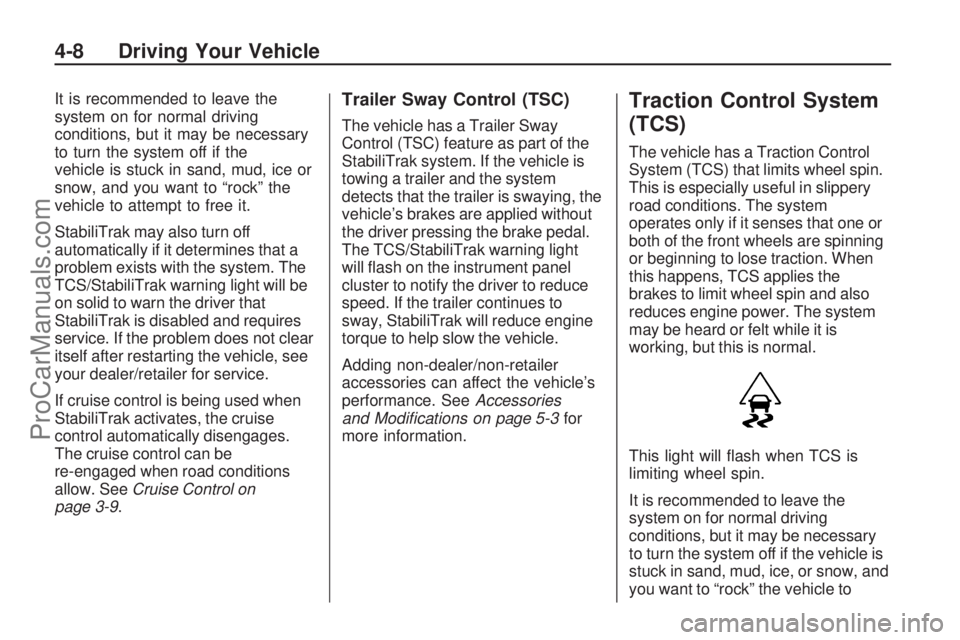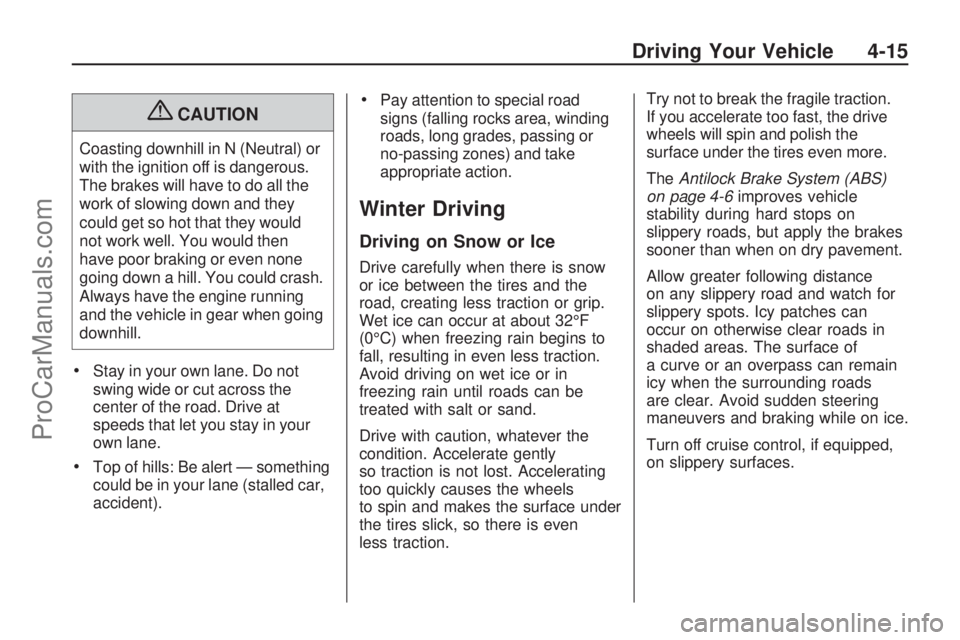cruise control SATURN VUE HYBRID 2009 User Guide
[x] Cancel search | Manufacturer: SATURN, Model Year: 2009, Model line: VUE HYBRID, Model: SATURN VUE HYBRID 2009Pages: 346, PDF Size: 2.1 MB
Page 194 of 346

It is recommended to leave the
system on for normal driving
conditions, but it may be necessary
to turn the system off if the
vehicle is stuck in sand, mud, ice or
snow, and you want to “rock” the
vehicle to attempt to free it.
StabiliTrak may also turn off
automatically if it determines that a
problem exists with the system. The
TCS/StabiliTrak warning light will be
on solid to warn the driver that
StabiliTrak is disabled and requires
service. If the problem does not clear
itself after restarting the vehicle, see
your dealer/retailer for service.
If cruise control is being used when
StabiliTrak activates, the cruise
control automatically disengages.
The cruise control can be
re-engaged when road conditions
allow. SeeCruise Control on
page 3-9.Trailer Sway Control (TSC)
The vehicle has a Trailer Sway
Control (TSC) feature as part of the
StabiliTrak system. If the vehicle is
towing a trailer and the system
detects that the trailer is swaying, the
vehicle’s brakes are applied without
the driver pressing the brake pedal.
The TCS/StabiliTrak warning light
will �ash on the instrument panel
cluster to notify the driver to reduce
speed. If the trailer continues to
sway, StabiliTrak will reduce engine
torque to help slow the vehicle.
Adding non-dealer/non-retailer
accessories can affect the vehicle’s
performance. SeeAccessories
and Modifications on page 5-3for
more information.
Traction Control System
(TCS)
The vehicle has a Traction Control
System (TCS) that limits wheel spin.
This is especially useful in slippery
road conditions. The system
operates only if it senses that one or
both of the front wheels are spinning
or beginning to lose traction. When
this happens, TCS applies the
brakes to limit wheel spin and also
reduces engine power. The system
may be heard or felt while it is
working, but this is normal.
This light will �ash when TCS is
limiting wheel spin.
It is recommended to leave the
system on for normal driving
conditions, but it may be necessary
to turn the system off if the vehicle is
stuck in sand, mud, ice, or snow, and
you want to “rock” the vehicle to
4-8 Driving Your Vehicle
ProCarManuals.com
Page 199 of 346

Driving in Rain and on
Wet Roads
Rain and wet roads can reduce
vehicle traction and affect your
ability to stop and accelerate.
Always drive slower in these types
of driving conditions and avoid
driving through large puddles and
deep-standing or �owing water.
{CAUTION
Wet brakes can cause crashes.
They might not work as well in a
quick stop and could cause
pulling to one side. You could
lose control of the vehicle.
(Continued)
CAUTION (Continued)
After driving through a large
puddle of water or a car/vehicle
wash, lightly apply the brake
pedal until the brakes work
normally.
Flowing or rushing water creates
strong forces. Driving through
�owing water could cause your
vehicle to be carried away. If this
happens, you and other vehicle
occupants could drown. Do not
ignore police warnings and be
very cautious about trying to drive
through �owing water.
Hydroplaning
Hydroplaning is dangerous. Water
can build up under your vehicle’s
tires so they actually ride on
the water. This can happen if theroad is wet enough and you are
going fast enough. When your
vehicle is hydroplaning, it has little
or no contact with the road.
There is no hard and fast rule about
hydroplaning. The best advice is
to slow down when the road is wet.
Other Rainy Weather Tips
Besides slowing down, other wet
weather driving tips include:
Allow extra following distance.
Pass with caution.
Keep windshield wiping
equipment in good shape.
Keep the windshield washer �uid
reservoir �lled.
Have good tires with proper tread
depth. SeeTires on page 5-38.
Turn off cruise control.
Driving Your Vehicle 4-13
ProCarManuals.com
Page 201 of 346

{CAUTION
Coasting downhill in N (Neutral) or
with the ignition off is dangerous.
The brakes will have to do all the
work of slowing down and they
could get so hot that they would
not work well. You would then
have poor braking or even none
going down a hill. You could crash.
Always have the engine running
and the vehicle in gear when going
downhill.
Stay in your own lane. Do not
swing wide or cut across the
center of the road. Drive at
speeds that let you stay in your
own lane.
Top of hills: Be alert — something
could be in your lane (stalled car,
accident).
Pay attention to special road
signs (falling rocks area, winding
roads, long grades, passing or
no-passing zones) and take
appropriate action.
Winter Driving
Driving on Snow or Ice
Drive carefully when there is snow
or ice between the tires and the
road, creating less traction or grip.
Wet ice can occur at about 32°F
(0°C) when freezing rain begins to
fall, resulting in even less traction.
Avoid driving on wet ice or in
freezing rain until roads can be
treated with salt or sand.
Drive with caution, whatever the
condition. Accelerate gently
so traction is not lost. Accelerating
too quickly causes the wheels
to spin and makes the surface under
the tires slick, so there is even
less traction.Try not to break the fragile traction.
If you accelerate too fast, the drive
wheels will spin and polish the
surface under the tires even more.
TheAntilock Brake System (ABS)
on page 4-6improves vehicle
stability during hard stops on
slippery roads, but apply the brakes
sooner than when on dry pavement.
Allow greater following distance
on any slippery road and watch for
slippery spots. Icy patches can
occur on otherwise clear roads in
shaded areas. The surface of
a curve or an overpass can remain
icy when the surrounding roads
are clear. Avoid sudden steering
maneuvers and braking while on ice.
Turn off cruise control, if equipped,
on slippery surfaces.
Driving Your Vehicle 4-15
ProCarManuals.com
Page 337 of 346

Child Restraints (cont.)
Securing a Child Restraint
in the Right Front Seat
Position.......................1-38
Where to Put the
Restraint......................1-29
Chime Level Adjustment........3-84
Cleaning
Aluminum Wheels.............5-72
Exterior Lamps/Lenses......5-70
Fabric/Carpet...................5-68
Finish Care......................5-70
Instrument Panel, Vinyl,
and Other Plastic
Surfaces......................5-69
Interior............................5-66
Leather...........................5-68
Tires...............................5-72
Underbody Maintenance....5-73
Washing Your Vehicle........5-69
Weatherstrips...................5-69
Windshield and Wiper
Blades.........................5-71
Climate Control System
Automatic........................3-17
Outlet Adjustment.............3-22
Clock, Setting......................3-56Collision Damage Repair......... 7-9
Compass............................3-40
Compressor Kit
Storing............................5-66
Compressor Kit, Tire
Sealant...........................5-59
Content Theft-Deterrent.........2-10
Control of a Vehicle............... 4-4
Convenience Net.................2-38
Coolant
Engine............................5-20
Engine Temperature
Warning Light...............3-29
Surge Tank
Pressure Cap...............5-22
Cooling System...................5-17
Cruise Control....................... 3-9
Cruise Control Light..............
3-33
Cupholders.........................2-37
Customer Assistance
Information
Courtesy Transportation....... 7-8
Customer Assistance for
Text Telephone (TTY)
Users............................ 7-4
Customer Assistance
Offices........................... 7-5
Customer Satisfaction
Procedure...................... 7-1Customer Assistance Information
(cont.)
GM Mobility
Reimbursement
Program........................ 7-5
Reporting Safety Defects to
Saturn.........................7-13
Reporting Safety Defects to
the Canadian
Government..................7-12
Reporting Safety Defects to
the United States
Government..................7-12
Roadside Assistance
Program........................ 7-5
Service Publications
Ordering Information......7-13
D
Daytime Running Lamp.........3-13
Defensive Driving................... 4-3
Delayed Locking.................... 2-6
DIC Compass......................3-40
Disc, MP3...........................3-66
Doing Your Own
Service Work..................... 5-4
Dome Lamp ........................3-14
INDEX i-3
ProCarManuals.com
Page 340 of 346

I
Ignition Positions..................2-14
Infants and Young Children,
Restraints........................1-25
In�ation - Tire Pressure.........5-43
In�ator Kit, Tire....................5-59
Instrument Panel
Brightness.......................3-14
Cluster............................3-23
Overview........................... 3-4
Intermediate Voltage Devices
and Wiring.......................5-74
J
Jump Starting......................5-28
K
Keyless Entry System............ 2-3
Keys.................................... 2-2
L
Labeling, Tire Sidewall..........5-39
Lamp
Malfunction Indicator.........3-30Lamps
Dome .............................3-14
Reading..........................3-14
Lap-Shoulder Belt................1-17
LATCH System for Child
Restraints........................1-31
License Plate Lamps............5-37
Liftgate
Carbon Monoxide............... 2-8
Light
Airbag Readiness.............3-25
Antilock Brake System
(ABS) Warning..............3-28
Brake System Warning......3-27
Change Engine Oil...........3-33
Charging System..............3-27
Cruise Control..................3-33
Engine Coolant
Temperature Warning.....3-29
Fuel Economy..................3-35
Highbeam On...................3-34
Low Fuel Warning.............3-34
Low Washer Fluid
Warning.......................3-34
Oil Pressure.....................3-33
Passenger Airbag Status
Indicator.......................3-26Light (cont.)
Safety Belt Reminders.......3-24
Security...........................3-33
StabiliTrak
®/Traction
Control System (TCS)
Warning Light...............3-28
Tire Pressure...................3-29
Light, Auto Stop Mode..........3-35
Lighting
Entry..............................3-14
Lights
Exterior Lamps.................3-12
Flash-to-Pass..................... 3-7
High/Low Beam Changer..... 3-7
Loading Your Vehicle............4-18
Lockout Protection................. 2-7
Locks
Automatic Door Lock.......... 2-7
Automatic Door Unlock........ 2-7
Delayed Locking................. 2-6
Door ................................. 2-6
Lockout Protection.............. 2-7
Power Door....................... 2-6
Rear Door Security Locks.... 2-7
Loss of Control....................4-11
Low Fuel Warning Light........3-34
Low Washer Fluid Warning
Light...............................3-34
i-6 INDEX
ProCarManuals.com